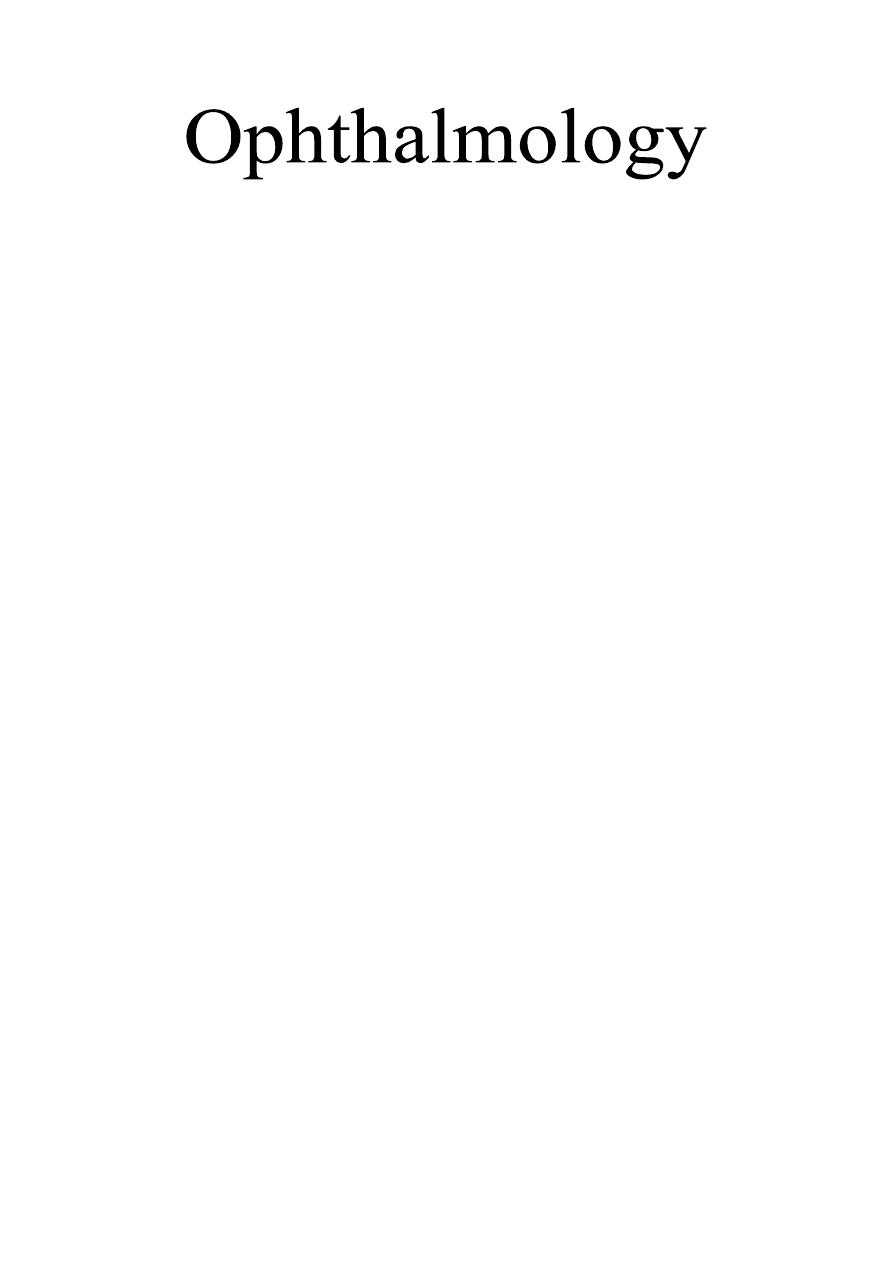
1
TRAUMA
D
R
A
BDUL MELIK SHALLAL
E
YELID TRAUMA
1- Haematoma (Black eyes) (Panda eyes):
It is the most common result of blunt injury to the eyelid or
forehead (due to continuous space below the tense aponeurosis of
scalp that extends to the loose space around the eye) and it is
generally innocuous. It is important to exclude the following
serious associated conditions:
a- Trauma to the globe.
b- Orbital walls fracture.
c- Basal skull fracture.
2- Laceration:
Two types of eyelid laceration:
a- Superficial lacerations: they are parallel to the lid margin
without gaping.
Treatment: suturing.
b- Lid margin lacerations: which are invariably gape and must
therefore be carefully sutured with perfect alignment to prevent
notching.
* Improper suturing may end with notching or fibrosis (scars) that
causes foreign body sensation and then might end with corneal
abrasion and its consequences.
O
RBITAL
F
RACTURES
- Blow-out floor fracture:
It is typically caused by sudden increase in the orbital pressure by
a striking object such as a fist or tennis ball. Since the bones of the
lateral wall and roof are usually able to withstand such trauma, the
fracture most frequently involves the floor and occasionally, the
medial orbital wall may also be fractured by such type of trauma.
Signs:
1- Periocular signs: include ecchymosis, oedema and
subcutaneous emphysema.

2
2- Infraorbtal nerve anesthesia: involving the lower lid, cheek,
side of the nose, upper lip, upper teeth and gums.
3- Vertical diplopia: happens due to:
a- Hemorrhage and oedema of the orbit restricting the movements
of the globe.
b- Mechanical entrapment of the inferior rectus or inferior oblique
muscle or both within the fracture.
c- Direct extraocular muscle injury.
4- Enophthalmos may be present if the fracture is large.
5- Ocular damage, e.g. hyphaema, angle recession and retinal
dialysis.
Treatment of Blow out floor fracture:
Initially, it is conservative with systemic antibiotics; the patient
should be instructed not to blow the nose to avoid transmission of
bacteria from maxillary sinus to the orbit.
Subsequently, it is aimed at prevention of permanent vertical
diplopia and/or cosmetically unacceptable enophthalmos.
Indications of surgery:
1- Wait for 2 weeks (not more as fibrosis make the surgery difficult
or impossible) until hemorrhage, edema and inflammation
settles, then check for diplopia in primary position and down
gaze, if the diplopia still exists after 2 weeks then, surgery is
indicated to release the muscles and to cover the defective
fractured bone by bone graft or synthetic materials.
2- Enophthalmos more than 2 mm which causing cosmetic blemish.
T
RAUMA TO THE GLOBE
- Closed injury: it is commonly seen due to blunt trauma. The outer
corneoscleral wall of the globe is intact; however, intraocular
damage may be present.
- Open injury: it involves a full-thickness wound of the
corneoscleral wall.
Open injury can occur by the following mechanisms:
1- Blunt trauma: can lead to a full-thickness wound at its weakest
point. This is called rupture globe.
2- Trauma by sharp object: e.g. knife can cause a full-thickness
wound which is called laceration.
3- Trauma by high velocity sharp object: e.g., shell injury, small
foreign bodies scattering from hammer or other material, which can

3
cause single full-thickness wound without an exit wound (there is
intraocular retention of the foreign body), this type of wound is
called "Penetration wound". If it cause two full-thickness
wounds, one entry and one exit, which is usually caused by a
missile (no retention of the foreign body), this type of wound called
"Perforation wound".
General principles of management:
1- Initial assessment:
a- Determination of any associated life-threatening problems,
and general condition should be stabilized.
b- History: circumstances, timing and likely object.
c- Thorough examination of both eyes and orbits.
2- Special investigations:
a- Plain radiographs: when a foreign body is suspected, to
localize it and plan for the surgery.
b- CT: superior to plain x ray in detection and localization of
intraorbital foreign body. It is also used in determining the
integrity of intracranial, facial and intraocular structures.
* NB: MRI should never be performed if a metallic foreign body
is suspected as this may induce more traumas and damage by its
movement again.
c- Ultrasound: detection of intraorbital foreign body, globe
rupture (as the rupture may be posteriorly hidden), retinal
detachment.
d- Electrophysiological tests (VEP, EOG, ERG) in assessing the
integrity of the optic nerve and retina.
B
LUNT TRAUMA
Causes: squash balls, luggage straps and champagne corks.
Complications:
1- Anterior segment complications:
a- Corneal abrasion: epithelial loss, which stains with
fluorescein, treated by pressure bandage for 24 to 48 hours.
b- Hyphaema: hemorrhage in the anterior chamber usually occurs
in children and young persons. The source of bleeding is the iris
or ciliary body. Secondary bleeding can occur during the first
week and is more serious than initial bleeding.
* Hyphaema may cause secondary glaucoma by three ways:
EITHER
through occluding of the trabecular meshwork by blood

4
cells and proteins,
OR
by pupillary block (due to clot that
occludes pupil) OR by the associated iritis and its
complications e.g. Anterior and posterior synechia. Corneal
staining (haemosiderosis) can occurs duo to persistent
Hyphaema specially if associated with rising IOP. It is due to
deposition of iron on corneal endothelium which leads to sever
affection of VA where penetrating keratoplasty indicated.
* If hyphaema fills more than half of the anterior chamber, the
patient should be admitted to hospital with complete bed rest,
and if it is mild hyphaema and fills less than half of the anterior
chamber, the patient is discharged but with complete bed rest in
home. Bed rest is important step in treatment of hyphaema to
avoid secondary bleeding.
* Surgery ("Paracentesis") is indicated when there is:
1- persistent total hyphema.
2- sever and persistent rising IOP.
3- corneal staining.
In paracentesis, washing of AC is usually done with replacement
of blood by a visco-elasitc substance or fluid e.g. normal saline,
ringer solution or balance salts solution (BSS).
When sugery not indicated cycloplegia, topical steroids, bed rest,
IOP monitoring & follow up are required.
c- Traumatic mydriasis: it is often permanent due to damage to
the iris sphincter muscles. Permanent large mydriasis lead to
photophobia an blurred vision.
d- Iridodialysis: is a dehiscence of the iris from the ciliary body at
its root. Usually the pupil has a D shape and the vertical part of
D is toward the dehiscent. It is innocuous and asymptomatic or
occasionally can cause monocular diplopia (2 pupils).
e- Ciliary body: - Ciliary shock (ocular hypotonia).
- Anterior chamber angle recession (lead to
glaucoma).
* AC angle recession: recession of the angle between the periphery
of the iris and anterior face of ciliary body, which seen by
gonioscopy. Angle recession per se is an innocuous thing, but may
indicate severe trauma and associated with damage to the trabecular
meshwork that may cause "Angle recession glaucoma". This type

5
of secondary glaucoma might occur after months or even a long
time (years).
f- Lens: cataract. R: surgery
g- Rupture of the globe: usually anterior with prolapse of
intraocular tissues, but occasionally posterior (occult).
2- Posterior segment complications:
a- PVD (posterior vitreous detachment): it may be associated
with vitreous hemorrhage or retinal tear (where pigment cells
similar to tobacco dust may be seen floating in the anterior
vitreous).
b- Commotio retinae: concussion of the sensory retina resulting
in cloudy swelling area of retina due to damage of inner part of
blood retinal barrier. If the oedema is persists and involving the
macula, it will cause cystoid macular edema (CME) and
permanent diminish of VA.
c- Choroidal rupture.
d- Retinal break: retinal dialysis, tears and holes.
* Retinal dialysis: dis insertion of part of the extreme periphery of
sensory retina from its attachment to the non-pigmented epithelium
of ciliary body.
e- Optic neuropathy: is an uncommon but often devastating
cause of permanent visual loss.
f- Optic nerve avulsion: is rare and typically occurs when an
object intrudes between the globe and the orbital wall,
displacing the eye.
P
ENETRATING TRAUMA
Causes:
Penetrating trauma is three times more common in males than in
females, and in younger age group than in old age group. The most
frequent causes are assault, domestic accidents and sort. The extent
of the injury is determined by the size of the object, its speed at the
time of impact and its composition.
Complications:
1- Anterior segment complications:

6
a- Small corneal lacerations: with formed anterior chamber, it
does not require suturing as it heals spontaneously.
b- Medium-sized corneal lacerations: usually require suturing to
reform the anterior chamber, especially if the anterior chamber
is shallow or flat.
c- Corneal lacerations with iris prolapse:
In the 1
st
24h, reposition of the iris (still viable) and suturing of
lacerations.
After the 1
st
24h, the iris should be excised and then suture the
lacerations.
d- Corneal lacerations with lenticular (lens) damage:
Suturing of the laceration and removing of the damaged lens and
replaced by IOL.
e- Anterior scleral laceration ± Iridociliary prolapse and
vitreous incarceration:
If (-) i.e. Anterior scleral laceration only, then suturing only,
If (+), then reposition of exposed viable uveal tissue and cut
prolapsed vitreous flush within the wound otherwise
subsequent vitreoretinal traction occur and lead to retinal
detachment.
2- Posterior segment complications:
- Posterior scleral lacerations: usually associated with retinal
breaks unless very superficial. The sclera should be sutured
with treatment of retinal break prophylactically by cryotherapy
to avoid rhegmatogenous R.D.
I
NTRAOCULAR FOREIGN BODIES
An Intraocular foreign body may traumatize the eye by the
following mechanisms:
1- Mechanically (laceration).
2- Introduce infection.
3- Toxic effects on the intraocular structures.
Stones and organic foreign bodies are prone to result in infections.
Glass, plastics, gold and silver are inert and can be left with no
harmful effect.
Iron and copper foreign bodies undergo dissociation and result in
siderosis and chalcosis respectively. These foreign bodies should
be removed immediately or within few days.

7
Siderosis:
Intraocular ferrous foreign body undergoes dissociation resulting
in the deposition of Iron in the intraocular epithelial cells (especially
in lens and retina) that leads to toxic effect on cellular enzymes that
leads to cell death.
Features of siderosis:
Which are: cataract, reddish-brown staining of the iris, secondary
glaucoma (due to trabecular meshwork deposition) and pigmentary
retinopathy (blindness).
Treatment: iron foreign body should be removed.
Chalcosis:
The ocular reaction to an intraocular foreign body with a high
copper content involves a violent endophthalmitis-like picture which
often progress to phthisis bulbi.
Treatment: Copper foreign body should be removed.
* Endophthalmitis means that there is inflammation of all intraocular
structures except the sclera, but if inflammation involves the sclera it
is called "Panophthalmitis".
E
NUCLEATION
(E
XCISION OF THE EYEBALL
)
Primary enucleation: should be performed only for sever injuries,
with no prospect of retention of vision when it is impossible to repair
the sclera.
It has been recommended that enucleation should be performed
within 10 days of the original injury in order to prevent the very
remote possibility of sympathetic ophthalmitis.
Secondary enucleation: may be considered following primary repair
if the eye is severely and irreversibly damaged, particularly if it is
also unsightly and uncomfortable.
S
YMPATHETIC
O
PHTHALMITIS
It is a very rare, bilateral, granulomatous panuveitis which occurs
after open ocular injuries usually associated with uveal prolapse or
less frequently following intraocular surgery, when the uveal tissue
came in contact with conjunctiva. It occurs due to antibody
formation against the uveal tract lead to severe immunological
inflammation of the injured eye and the fellow eye.

8
The traumatized eye is referred to as the "exciting eye", and the
fellow eye, which also develop uveitis, is called "Sympathizing
eye".
Presentation:
65% of cases present between 2 weeks to 3 months after initial
injury, 90% of all cases occur within the first year but it can occurs
later on after many years e.g. 20 years.
Signs:
- The exciting eye shows evidence of the initial trauma and is
frequently very red and irritable.
- The sympathizing eye becomes photophobic and irritable.
- Both eyes then develop a chronic granulomatous anterior uveitis
with iris nodules and large keratic precipitates.
- Bilateral disc swelling and multifocal choroiditis.
Course:
Rarely, the uveitis is mild and self-limiting, but usually,
intraocular inflammation becomes chronic and if not treated
appropriately, it may lead to cataract, glaucoma and phthisis bulbi in
both eyes.
Treatment:
1- Systemic steroid.
2- Topical steroid.
3- Short acting mydriatics.
4- Systemic Immunosuppressive agents in resistant cases.
But the prognosis is usually poor
Chemical injuries
Causes
Chemical injuries range in severity from the trivial to the potentially
blinding. The majority are accidental, and a few due to assault. Two-
thirds of accidental burns occur at work and the remainder at home.
Alkali burns are twice as common as acid burns since alkalis are
more widely used both at home and in industry. The severity of a
chemical injury is related to the properties of the chemical, the area
of affected ocular surface, duration of exposure (including retention
of particulate chemical on the surface of the globe or under the upper

9
lid) and related effects such as thermal damage. Alkalis tend to
penetrate more deeply than acids, as the acids coagulate surface
proteins, forming a protective barrier. The most common involved
alkalis are ammonia, sodium hydroxide and lime. The commonest
acids implicated are sulphuric, sulphurous, hydrofluoric, acetic,
chromic and hydrochloric. Ammonia and sodium hydroxide may
produce severe damage because of rapid penetration. Hydrofluoric
acid used in glass etching and cleaning also tends to rapidly
penetrate the eye, whilst sulphuric acid may be complicated by
thermal effects and high velocity impact after car battery explosions.
Management
a) Emergency treatment: should started as soon as
possible (before history & exam)
1 Copious irrigation is crucial to minimize duration of contact
with the chemical and normalize the pH in the conjunctival sac as
soon as possible, and the speed and efficacy of irrigation is the most
important prognostic factor following chemical injury. A sterile
balanced buffered solution, such as normal saline or Ringer lactate
should be used to irrigate the eye for 15–30 minutes or until pH is
neutral (tap water should be used if necessary to avoid any delay).
A topical anaesthetic should be instilled prior to irrigation, as this
dramatically improves comfort and facilitates cooperation. A lid
speculum may be helpful.
2 Double-eversion of the upper eyelid should be performed so
that any retained particulate matter trapped in the fornices is
identified and removed.
3 Debridement of necrotic areas of corneal epithelium should be
performed to promote re-epithelialization and remove associated
chemical residue.
4 Admission to hospital will usually be required for severe
injuries (grade 4 ± 3) in order to ensure adequate eye drop
instillation in the early stages.
b) Detailed history, examination & grading of severity:
Grading is performed on the basis of corneal clarity and severity of
limbal ischaemia (Roper-Hall system); the latter is assessed by
observing the patency of the deep and superficial vessels at the
limbus

10
Grade 1 is characterized by clear cornea (epithelial damage only)
and no limbal ischaemia (excellent prognosis).
Grade 2 shows hazy cornea but with visible iris details and less
than one-third of the limbus being ischaemic (good prognosis).
Grade 3 manifests total loss of corneal epithelium, stromal haze
obscuring iris details and between one-third and half limbal
ischaemia (guarded prognosis).
Grade 4 shows opaque cornea and more than half limbal ischaemia
(very poor prognosis).
c) Medical treatment:
Most mild (grade 1 and 2) injuries are treated with topical antibiotic
ointment for about a week, with topical steroids and cycloplegics if
necessary. The main aims of treatment of more severe burns are to
reduce inflammation, promote epithelial regeneration and
prevent corneal melting. For moderate-severe injuries,
preservative-free drops should be used.
1 Steroids & NSAIDs. steroids reduce inflammation and
neutrophil infiltration, and address anterior uveitis. However,
they also impair stromal healing by reducing collagen synthesis
and inhibiting fibroblast migration. For this reason topical
steroids may be used initially but must be tailed off after 7–10
days when sterile corneal ulceration is most likely to occur.
Steroids may be replaced by topical NSAIDs, which do not
affect keratocyte function.
2 Cycloplegia to decrease pain.
3 Topical antibiotic drops are used for prophylaxis of bacterial
infection (e.g. chloramphenicol q.i.d.).
4 Ascorbic acid (for healing &scar maturation) reverses a
localized tissue scorbutic state and improves wound healing,
promoting the synthesis of mature collagen by corneal
fibroblasts. Topical sodium ascorbate 10% is given 2-hourly in
addition to a systemic dose of 1–2 g vitamin C (L-ascorbic
acid) q.i.d. (not in patients with renal disease).
5 Citric acid (Anti-inflammatory Anti collagenase) is a powerful
inhibitor of neutrophil activity and reduces the intensity of the
inflammatory response. Chelation of extracellular calcium by
citrate also appears to inhibit collagenase. Topical sodium
citrate 10% is given 2-hourly for about 10 days, and may also

11
be given orally (2 g four times daily). The aim is to eliminate
the second wave of phagocytes, which normally occurs about 7
days after the injury. Ascorbate and citrate can be tapered as
the epithelium heals.
6 Tetracyclines (Anti collagenase Anti-inflammatory) are
effective collagenase inhibitors and also inhibit neutrophil
activity and reduce ulceration. They should be considered if
there is significant corneal melting and can be administered
both topically (tetracycline ointment q.i.d.) and systemically
(doxycycline 100 mg b.d. tapering to once daily).
Acetylcysteine 10% drops 6 times daily are an alternative
topical anticollagenase agent.
d) Surgery:
1 Early surgery may be necessary to promote revascularization of
the limbus, restore the limbal cell population and re-establish the
fornices. One or more of the following procedures may be used:
• Advancement of Tenon's capsule and suturing to the limbus is
aimed at re-establishing limbal vascularity thus preventing the
development of corneal ulceration.
• Limbal stem cell transplantation from the patient's other eye
(autograft) or from a donor (allograft) is aimed at restoring normal
corneal epithelium.
• Amniotic membrane grafting to promote epithelialization and
suppression of fibrosis.
• Gluing or keratoplasty may be needed for actual or impending
perforation.
2 Late surgery may involve the following procedures:
• Division of conjunctival bands and treating symblepharon
• Conjunctival or mucous membrane grafts.
• Correction of eyelid deformities .
• Keratoplasty should be delayed for at least 6 months and
preferably longer to allow maximal resolution of inflammation.
• Keratoprosthesis may be required in very severely damaged
eyes because the results of conventional grafting are poor
.

12
References
:
Clinical Ophthalmology A Systematic Approach ;
Jack J
Kanski & Brad Bowling.
Learning objectives:
g
